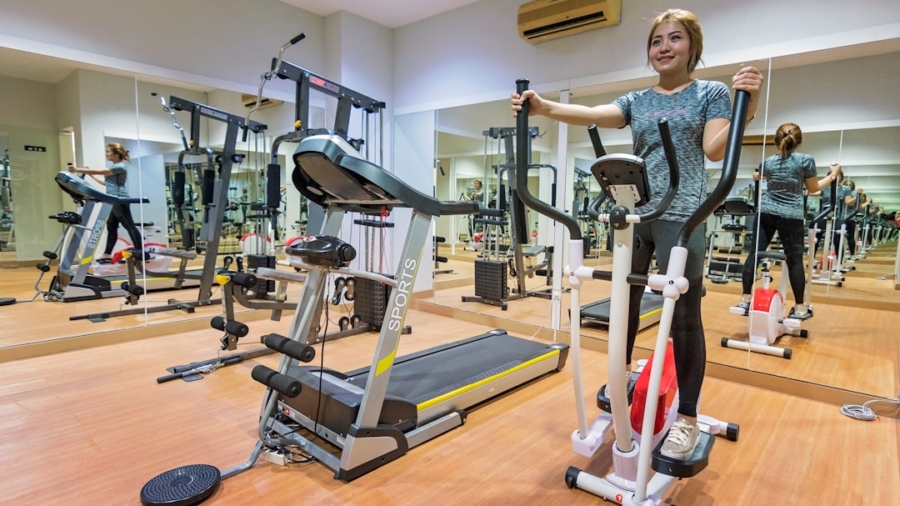The Internet of Things (IoT) has revolutionized various sectors, and the fitness industry is no exception. By integrating smart devices and sensors into home fitness routines, individuals can now access personalized workout programs that cater to their unique needs and preferences. This technological advancement allows for a more tailored approach to fitness, moving away from one-size-fits-all solutions.
As people increasingly seek ways to maintain their health and wellness from the comfort of their homes, the intersection of IoT and personalized fitness programs has become a focal point for innovation. Personalized home fitness programs leverage IoT technology to create an interactive and engaging experience for users. These programs utilize data collected from various devices to understand an individual’s fitness level, goals, and preferences.
This information is then used to design customized workout plans that adapt over time, ensuring that users remain motivated and challenged. The convenience of accessing these programs at home, combined with the ability to track progress in real-time, has made IoT-driven fitness solutions increasingly popular among a diverse range of individuals, from beginners to seasoned athletes.
Key Takeaways
- IoT enables personalized home fitness programs by connecting devices and sensors to collect and analyze data for customized workouts and training plans.
- The benefits of IoT in personalized home fitness programs include real-time monitoring, data-driven insights, and the ability to track progress and make adjustments as needed.
- IoT devices and sensors for personalized home fitness include smart scales, heart rate monitors, activity trackers, and connected workout equipment.
- Data collection and analysis in personalized home fitness programs with IoT allows for personalized recommendations and adjustments based on individual performance and goals.
- The future of IoT in personalized home fitness programs holds potential for even more advanced data collection, analysis, and customization, but also presents challenges such as data privacy and security concerns.
The Benefits of IoT in Personalized Home Fitness Programs
One of the most significant benefits of IoT in personalized home fitness programs is the ability to provide real-time feedback. Traditional workout routines often lack immediate guidance, which can lead to improper form or ineffective exercises. However, with IoT-enabled devices such as smart wearables and connected fitness equipment, users receive instant feedback on their performance.
For instance, a smart treadmill can analyze a runner’s gait and provide suggestions for improvement, while a wearable fitness tracker can monitor heart rate and suggest adjustments to maintain optimal training zones. Moreover, IoT technology enhances motivation through gamification and social connectivity. Many IoT fitness applications incorporate elements such as challenges, leaderboards, and social sharing features that encourage users to stay engaged with their fitness goals.
For example, platforms like Strava allow users to share their workouts with friends, fostering a sense of community and accountability. This social aspect can be particularly beneficial for individuals who may struggle with motivation when exercising alone at home.
IoT Devices and Sensors for Personalized Home Fitness

The landscape of IoT devices designed for personalized home fitness is vast and continually evolving. Wearable technology, such as smartwatches and fitness trackers, plays a crucial role in this ecosystem. These devices are equipped with sensors that monitor various metrics, including heart rate, steps taken, calories burned, and even sleep patterns.
For instance, the Fitbit Charge series offers comprehensive health tracking features that allow users to gain insights into their daily activity levels and overall wellness. In addition to wearables, smart home gym equipment has gained traction in recent years. Devices like Peloton bikes and Mirror offer interactive workout experiences that adapt to individual user profiles.
These machines often come equipped with cameras and microphones that enable trainers to provide real-time feedback during live classes. Furthermore, smart weights and resistance bands can adjust their difficulty based on the user’s performance, ensuring that workouts remain challenging yet achievable.
Data Collection and Analysis in Personalized Home Fitness Programs
Data collection is at the heart of personalized home fitness programs powered by IoT technology.
This data encompasses not only physical metrics but also behavioral patterns, such as workout frequency and duration.
By analyzing this information, fitness programs can identify trends and make informed recommendations tailored to each user’s needs. Advanced analytics tools play a pivotal role in transforming raw data into actionable insights. Machine learning algorithms can process vast amounts of information to identify correlations between different variables.
For example, an analysis might reveal that a user performs better when they engage in strength training three times a week rather than focusing solely on cardio exercises. Such insights enable users to optimize their training regimens based on empirical evidence rather than guesswork.
Customized Workouts and Training Plans with IoT
The ability to create customized workouts is one of the standout features of IoT-driven personalized home fitness programs. By leveraging data collected from wearables and other devices, these programs can generate training plans that align with an individual’s goals—be it weight loss, muscle gain, or improved endurance. For instance, if a user aims to run a marathon, the program can design a progressive training schedule that gradually increases mileage while incorporating rest days to prevent injury.
Moreover, the adaptability of these programs is a significant advantage. As users progress in their fitness journeys, their needs may change. IoT-enabled systems can automatically adjust workout plans based on performance metrics or user feedback.
If a user consistently finds certain exercises too easy or too challenging, the program can modify the intensity or introduce new movements to keep the workouts fresh and engaging.
Monitoring and Tracking Progress with IoT in Personalized Home Fitness

Monitoring progress is essential for maintaining motivation and achieving fitness goals. IoT technology facilitates this process by providing users with real-time data on their performance. Many fitness apps offer dashboards that display key metrics such as workout duration, calories burned, and heart rate trends over time.
This visual representation of progress can be incredibly motivating, as users can see tangible results from their efforts. Additionally, some IoT devices come equipped with features that allow for long-term tracking of health metrics beyond just fitness performance. For example, smart scales can measure body composition metrics such as body fat percentage and muscle mass in addition to weight.
This holistic approach enables users to understand how their fitness routines impact their overall health rather than focusing solely on weight loss or muscle gain.
Challenges and Considerations in Implementing IoT in Personalized Home Fitness Programs
Despite the numerous advantages of integrating IoT into personalized home fitness programs, several challenges must be addressed for successful implementation. One significant concern is data privacy and security. As users share sensitive health information with connected devices and applications, ensuring that this data is protected from breaches becomes paramount.
Companies must adhere to strict regulations regarding data handling and provide transparent privacy policies to build trust with users. Another challenge lies in the potential for technology overload. With an abundance of devices and applications available on the market, users may feel overwhelmed by the choices at their disposal.
This saturation can lead to decision fatigue or frustration if individuals struggle to find the right combination of tools that work for them. To mitigate this issue, companies should focus on creating user-friendly interfaces and providing clear guidance on how to effectively utilize their products.
The Future of IoT in Personalized Home Fitness Programs
Looking ahead, the future of IoT in personalized home fitness programs appears promising as technology continues to advance at an unprecedented pace. Innovations such as artificial intelligence (AI) are expected to play a more significant role in enhancing user experiences. AI algorithms could analyze user data more comprehensively, offering even more precise recommendations for workouts and nutrition based on individual preferences and goals.
Furthermore, the integration of virtual reality (VR) and augmented reality (AR) into home fitness experiences could transform how users engage with their workouts. Imagine participating in a virtual cycling class where you can ride alongside friends in a simulated environment or using AR glasses that overlay real-time performance metrics during strength training sessions. These immersive experiences could make home workouts more enjoyable while maintaining the personalized touch that IoT provides.
As the demand for personalized health solutions continues to grow, it is likely that we will see an increase in collaborations between tech companies and fitness professionals. Such partnerships could lead to the development of more sophisticated platforms that combine expert knowledge with cutting-edge technology, ultimately enhancing the effectiveness of personalized home fitness programs. In conclusion, the integration of IoT into personalized home fitness programs represents a significant leap forward in how individuals approach their health and wellness journeys.
By harnessing the power of data collection, real-time feedback, and customized training plans, users can achieve their fitness goals more effectively than ever before while enjoying the convenience of working out at home. As technology continues to evolve, so too will the possibilities for creating even more engaging and effective personalized fitness experiences.
As IoT devices become more integrated into our daily lives, they offer unprecedented opportunities for customizing fitness routines to meet individual needs. For those interested in exploring how technology can enhance personal experiences beyond fitness, the article on Unlock the Possibilities with Samsung Galaxy S22 provides insights into how advanced features in modern smartphones can further complement and enhance the IoT ecosystem, offering seamless connectivity and innovative applications that can be leveraged for a more holistic approach to personal health and wellness.
FAQs
What is IoT?
IoT stands for Internet of Things, which refers to the network of physical devices, vehicles, home appliances, and other items embedded with electronics, software, sensors, actuators, and connectivity which enables these things to connect and exchange data.
How does IoT play a role in personalized home fitness programs?
IoT can play a role in personalized home fitness programs by connecting fitness equipment, wearable devices, and other smart home devices to gather data on an individual’s fitness activities, health metrics, and environmental factors. This data can then be used to tailor personalized fitness programs and provide real-time feedback and guidance.
What are some examples of IoT devices used in personalized home fitness programs?
Examples of IoT devices used in personalized home fitness programs include smart fitness equipment such as treadmills and stationary bikes, wearable fitness trackers, smart scales, heart rate monitors, and smart home devices such as smart lights and thermostats that can create an optimal workout environment.
How does IoT technology benefit personalized home fitness programs?
IoT technology benefits personalized home fitness programs by providing real-time data on an individual’s fitness activities, health metrics, and environmental factors. This data can be used to create personalized workout plans, track progress, and provide feedback and guidance to help individuals reach their fitness goals.
What are the potential challenges of using IoT in personalized home fitness programs?
Potential challenges of using IoT in personalized home fitness programs include data privacy and security concerns, interoperability issues between different devices and platforms, and the need for individuals to understand and manage the technology to ensure it is used effectively and safely.

